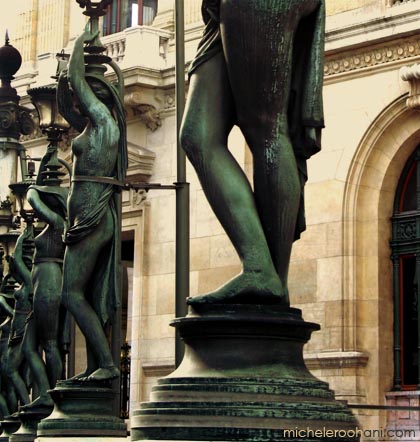I’ve always loved these ladies! I have fun playing with their images. They’ve been called torchères (torchieres), lampposts and some pretty banal names but I think that they deserve to be called by a “grander” name like “the green Lucinas” (Lucina: she who brings children into the light). I’ve photographed them several times (they are the best models, they never move). Their color changes from bronze green to dark jade passing by some moss and celadon.
The Paris opera house is not hosting any operas; it is now mainly used for ballet performances. Carrier-Belleuse, an old friend of Charles Garnier, the architect of this great theater, contributed the elaborate torcheres that hold the candelabra illuminating the grand staircase and the lampposts outside the opera house.
“Opera is where a guy gets stabbed in the back, and instead of dying, he sings.“ Robert Burns




Thank you Michele Roohani for bringing on to our work tables an air of Paris, the humor of Robert Burns and your exquisite taste of photography. Your web site is unmatched.
Askin
DE L’OPERA GARNIER
J’AVAIS DIX ANS LORSQUE J’EUS L’OCCASION D’AVOIR UN AVANT-GOUT DE L’EUROPE. J’AI GARDE EN MEMOIRE DES FRAGMENTS DE JOURNEES ET DE NUITS, DES IMAGES DE MES HOTELS, L’ANIMATION DES RUES, DIFFERENTE DE CELLE QUE JE CONNAISSAIS ET UNE IMPRESSION GLOBALE DE CHOSES ANCIENNES ET LUXUEUSES. TOUT CELA FAISAIT UN MONDE SITUE AUX ANTIPODES DE L’ITALIE.
JE VIS MONACO, GENEVE, HEIDELBERG, LONDRES, QUI EST RESTE JUSQU’A CE JOUR POUR MOI UNE VILLE ETRANGERE, ET, ENFIN, LA CAPITALE DE MA DESTINEE: PARIS. JE NE REUSSIS A ATTRAPER AU VOL QUE DES IMPRESSIONS RAPIDES DE CE QUI DEVIENDRAIT PLUS TARD UNE PARTIE INTEGRANTE DE MA VIE. CERTAINS MOMENTS DE CE VOYAGE, CEPENDANT, LAISSAIENT PRESAGER L’AVENIR.
“PROFITES-EN BIEN!
QUI SAIT SI TU REVIENDRAS ENCORE UNE FOIS ICI DANS TA VIE.
REGARDE!
ADMIRE!
C’EST PARIS!”
ME DISAIS-JE
MAIS JE SUIS REVENUE ET J’Y AI PASSE PLUSIEURS ANNEES, LES MEILLEURS DE MA VIE.
JE PROFITAI DE LA VISITE A L’OPERA GARNIER POUR RELIRE “LE FANTOME DE L’OPERA” DE GASTON LEROUX. ET, PAR MAGIE, JE RENTRAI DANS LE ROMAN CORPS ET AME. TOUT EN HAUT DES ESCALIERS, L’ESPACE D’UN INSTANT, IL ME SEMBLA QUE LES PERSONNAGES ALLAIENT APPARAITRE. QUE DIRE DE PLUS MIS A PART QUE JE TOMBAI AMOUREUSE DE CE ROMAN.
MAIS EN ETAIT-IL VRAIMENT UN?
ENVOUTANT!
LE REJET SOCIAL, L’AMOUR ET LA SOLITUDE CE SONT LES THEMES EVOQUES.
EXILE, REJETE PAR LE SEUL MILIEU QU’IL CONNAIT, LE FANTOME EST UN PERSONNAGE ROMANTIQUE A L’AME SENSIBLE QUI CONSACRE SA VIE A LA MUSIQUE. UN AMOUR SANS ESPOIR LE POUSSE A HANTER LES OMBRES D’UN MONDE QU’IL S’EST LUI-MEME CREE.
MALGRE UNE PRESENTATION UN PEU INDIGESTE AU DEBUT DE L’OEUVRE, LE LECTEUR EST TRES VITE ASPIRE PAR L’HISTOIRE.
LA PREMIERE DESCRIPTION DU FANTOME PLANTE EN QUELQUE SORT LE DECOR:
“IL EST D’UNE PRODIGIEUSE MAIGREUR ET SON HABIT FLOTTE SUR UNE CHARPENTE SQUELETTIQUE. ON NE VOIT, EN SOMME, QUE DEUX GRANDS TROUS NOIRS COMME AUX CRANES DES MORTS. SA PEAU, QUI EST TENDUE SUR L’OSSATURE COMME UNE PEAU DE TAMBOUR, N’EST POINT BLANCHE, MAIS JAUNE; SON NEZ EST SI PEU DE CHOSES QU’IL EST INVISIBLE DE PROFIL, ET C’EST L’ABSENCE DE CE NEZ QUI EST HORRIBLE A VOIR. TROIS OU QUATRE LONGUES MECHES BRUNES SUR LE FRONT ET DERRIERE LES OREILLES FONT OFFICE DE CHEVELURE”.
jE VOUS LE CONSEILLE!
BONNE SEMAINE A VOUS TOUS!
Rome, le 17 septembre 2007
D
Dordaneh,The GREEN LUCINAS lightened up my day for sure…thanks to you and your beautiful photographs 🙂
Not only your site offers great art, it also takes me back to a place that I love and have the most intimate memories! Who wouldn’t love the old Opera house in Paris with all its sentual sculptures? Many years ago I went to the opening of la Boheme in this beautiful place and the whole experience is still one of the most amazing one to cherish.
Thank you for your beautiful work of art.
Puisqu’il s’agit de statues, et uniquement de statues, je préfère les femmes qui versent de l’eau à celles qui brandissent une torche. C’est sûrement freudien et il faudra que j’en parle à mon analyste.L’esthétique de ces statues illustre assez bien l’esprit de la bourgeoisie industrielle française de l’époque : des femmes attirantes avec un joli visage, sans charmes excessifs cependant(pas de poitrine à la Jane Mainsfield) et avec des cuisses suffisamment solides et des hanches suffisamment larges pour assurer les nombreuses grossesses. Ces femmes respirent la santé et sont un gage de pérennité de la famille, de la dynastie, loin des maîtresses tuberculeuses telles que Violetta dans La Traviata.
Lyon, le 19 septembre 2007
MERCI MICHELE C’EST UNE BELLE JOURNEE.
Je découvre ce site avec un beaucoup de bonheur, et j’ajoute ici un complément à ces images qui font rêver :
Lucie vient de Lux, lumière. La lumière en effet est belle à voir, parce que, selon saint Ambroise, la lumière est naturellement gracieuse à la vue
Elle se répand ;sans se salir, quelque souillés que soient les lieux où elle se projette.
Ses rayons suivent une ligne sans la moindre courbe, et elle traverse une étendue immense sans mettre aucune lenteur
Lucie signifie aussi « chemin de lumière », en latin « Lucis Via »”
“Lucie comes from Lux, light. The light indeed is beautiful to see, because, according to saint Ambroise, the light is naturally graceful in the sight. It spreads without getting dirty, however soiled are the places where it falls.
and its beams follow a line without the slightest curve, and it crosses an immense area without putting any slowness………”
…Lucie can again mean Road of Light, Lucis, via.
Source: http://www.abbaye-saint-benoit.ch
Merci Micèle for this splendid journey in our beautiful city.
marie-ancolie Romanet